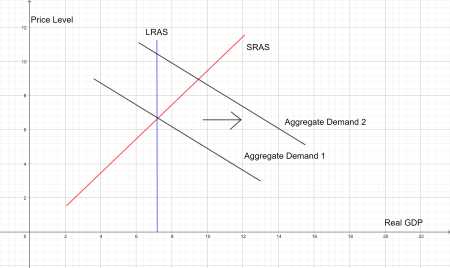Components of Aggregate Demand
1. Consumption

Consumption is the largest component of aggregate demand and represents the spending by households on goods and services. It includes purchases of durable goods (such as cars and appliances), non-durable goods (such as food and clothing), and services (such as healthcare and education). Consumption is influenced by factors such as disposable income, consumer confidence, and interest rates.
2. Investment

Investment refers to spending by businesses on capital goods, such as machinery, equipment, and buildings, as well as on research and development. It also includes residential investment, which represents the construction and purchase of new homes. Investment is influenced by factors such as interest rates, business confidence, and expected future profitability.
3. Government Spending
Government spending includes all expenditures by the government on goods and services, such as defense, infrastructure, education, and healthcare. It also includes transfer payments, such as social security and welfare benefits. Government spending can be influenced by fiscal policy decisions, political priorities, and economic conditions.
4. Net Exports
Net exports represent the difference between exports and imports. Exports are goods and services produced domestically and sold to other countries, while imports are goods and services produced in other countries and purchased domestically. Net exports can be influenced by factors such as exchange rates, trade policies, and global economic conditions.
Aggregate demand is a fundamental concept in macroeconomics that measures the total demand for goods and services in an economy at a given time. It represents the sum of consumer spending, investment, government spending, and net exports.
To calculate aggregate demand, economists use the following formula:
Aggregate Demand = Consumer Spending + Investment + Government Spending + Net Exports
Consumer Spending: This component represents the total expenditure by individuals on goods and services. It includes spending on durable goods (such as cars and appliances), non-durable goods (such as food and clothing), and services (such as healthcare and education).
Investment: Investment refers to the expenditure on capital goods, such as machinery, equipment, and buildings. It includes both private investment by businesses and public investment by the government.
Government Spending: This component represents the total expenditure by the government on goods and services. It includes spending on public infrastructure, defense, education, healthcare, and social welfare programs.
Net Exports: Net exports measure the difference between a country’s exports and imports. If a country’s exports exceed its imports, it has a positive net export, contributing to aggregate demand. Conversely, if a country’s imports exceed its exports, it has a negative net export, reducing aggregate demand.
However, there are certain constraints that can affect aggregate demand. These constraints include:
Income and Wealth Distribution: Unequal income and wealth distribution can impact aggregate demand. When income and wealth are concentrated in the hands of a few individuals or groups, their spending may not be sufficient to drive overall demand in the economy.
Interest Rates and Credit Availability: High interest rates and limited access to credit can discourage consumer spending and investment, reducing aggregate demand. Conversely, low interest rates and easy credit availability can stimulate spending and investment, boosting aggregate demand.
Government Policies: Government policies, such as taxation and regulation, can affect aggregate demand. Higher taxes and excessive regulations can reduce disposable income and discourage investment, while lower taxes and deregulation can increase disposable income and stimulate investment.
Global Economic Conditions: Global economic conditions, such as recessions or economic booms in major trading partners, can impact a country’s net exports and, consequently, aggregate demand. A slowdown in global demand can reduce exports, while a strong global economy can increase exports and boost aggregate demand.
Calculation of Aggregate Demand

Aggregate demand is a key concept in macroeconomics that measures the total demand for goods and services in an economy. It is calculated by summing up the four main components: consumption, investment, government spending, and net exports.
Consumption: Consumption refers to the total spending by households on goods and services. It includes purchases of durable goods (such as cars and appliances), non-durable goods (such as food and clothing), and services (such as healthcare and education). Consumption is influenced by factors like disposable income, consumer confidence, and interest rates.
Investment: Investment represents the spending by businesses on capital goods, such as machinery, equipment, and buildings. It also includes spending on research and development. Investment is influenced by factors like interest rates, business confidence, and expected returns on investment.
Government spending: Government spending includes all expenditures by the government on goods and services. This includes spending on infrastructure projects, defense, education, healthcare, and social welfare programs. Government spending is influenced by fiscal policy decisions and political priorities.
Net exports: Net exports represent the difference between exports and imports. If a country’s exports exceed its imports, it has a positive net export value, indicating a trade surplus. Conversely, if imports exceed exports, it has a negative net export value, indicating a trade deficit. Net exports are influenced by factors like exchange rates, trade policies, and global economic conditions.
To calculate aggregate demand, the total spending on consumption, investment, government spending, and net exports is added together. This provides an overall measure of the demand for goods and services in the economy. Aggregate demand is an important indicator of economic activity and is used by policymakers to assess the health of the economy and make informed decisions.

Emily Bibb simplifies finance through bestselling books and articles, bridging complex concepts for everyday understanding. Engaging audiences via social media, she shares insights for financial success. Active in seminars and philanthropy, Bibb aims to create a more financially informed society, driven by her passion for empowering others.
